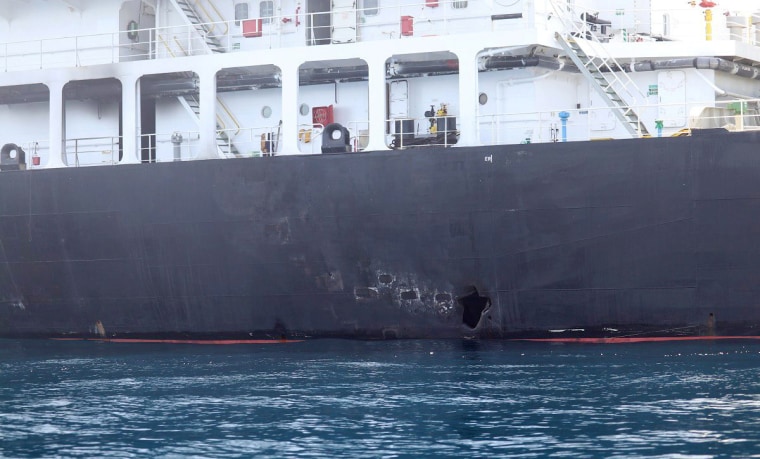U.S. NAVY BASE NEAR FUJAIRAH, UAE — The United States military said Wednesday that one of the tankers sabotaged in the Middle East was attacked with limpet mines that "bear a striking resemblance" to devices in Iran’s arsenal.
Officials have also found biometric information, including a handprint and fingerprints, on Kokuka Courageous, which "can be used to build a criminal case and hold the individuals responsible accountable," said Cmdr. Sean Kido with Task Group 56.1, which handles explosive ordinance, underwater diving and salvage.
The claim doubles down on Washington's belief that Iran was behind the attacks on the two ships in the Gulf of Oman close to the Iranian coast last week. Tehran has denied any involvement in the incident.
Secretary of State Mike Pompeo and Iranian President Hassan Rouhani have both said they do not seek a war. But some experts have questioned the speed at which officials within the Trump administration blamed Iran, while others worry that the incident has raised tensions that may spark an unintended conflict.
On Monday, the United States announced it was sending 1,000 more troops to the Middle East for what it said were defensive purposes. Meanwhile, Mohammed bin Salman, crown prince of Iran's archrival Saudi Arabia, said last week that he would not hesitate to confront regional threats.
On Wednesday, speaking at a U.S. Naval Forces Central Command facility near the United Arab Emirates port city of Fujairah, Kido said attacks on both the Kokuka Courageous and Front Altair, the other vessel sabotaged, were part of an investigation by the U.S. and its regional partners.
He said he was only able to discuss details relating to the Kokuka Courageous for now, without explaining why.
"The limpet mine that was used does bear a striking resemblance to that which has been publicly displayed in Iranian military parades," Kido said.
He said the devices appeared to have been fixed to the hull of the ship with magnets and nails. They were placed above the water line and "it does not appear that the intention was to sink the vessel," he said.
The devices had "distinguishing features" that would help U.S. explosive technicians identify exactly what type of device they are dealing with, he added.
This assessment contradicts a statement by the Japanese owner of one of the tankers, who previously said it was struck by a flying projectile. "What I can tell you is the damage that we examined is not consistent with an external flying object hitting the ship," Kido said.
He also mentioned again a video that the U.S. says shows an Iranian boat approaching the Kokuka Courageous after the explosion and removing an unexploded mine.
Courtney Kube reported from Fujairah, and Alexander Smith and Saphora Smith reported from London.


